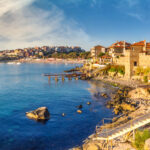
Tight lines of terraced vineyards climb Teide volcano, a towering peak that dominates the island of Tenerife. At just over 785 square miles, Tenerife is the largest of the Canary Islands, a Spanish archipelago off the northwest coast of Africa. Buffered by trade winds and year-round sunshine, Tenerife goes from balmy beaches to the alpine zone in a few steep miles, creating remarkably varied microclimates for grape growers.
“The island is like a mini continent,” said Olga Garcia Peceño, who leads private wine tours through her company Tenerife Wine Experience. “We can start harvesting in the south in mid-August, then finish in the north in October.” That diversity helps support five Denominations of Origin on Tenerife, in addition to a broader Canary Islands DO.
In recent years, Canary Islands wine has snagged the international spotlight, but viticulture is nothing new here: Historic drinkers from Benjamin Franklin to William Shakespeare gave shout outs to the archipelago’s finest. Not only that, the phylloxera that raged through European vineyards never touched the Canary Islands; some growers tend vines that are hundreds of years old.
Root stock isn’t the only holdover, since steep terrain has kept mechanization to a minimum here. Small growers still make the trek to hand-harvest mountainside vines, and many Canarians cultivate plots of grapes passed down between generations, selling their harvests to local vintners.

“It’s heroic agriculture,” said Garcia Peceño, whose own family vineyard is perched high on the slopes of Teide, “and there is a lot of passion put into wine here.” From the braided vines of the Orotava Valley to Abona’s arid hills, here’s what you need to know about Denominations of Origin in Tenerife.
DO Tacoronte-Acentejo
Dense, clay-rich soils in northeast Tenerife are planted with 2,422 hectares of steeply terraced vineyards, where Canary Islands classics such as listán negro, negramoll, listán blanco, marmajuelo, gual, and malvasía grapes thrive in misty conditions. Established in 1992, Tacoronte–Acentejo was the first Tenerife wine region to receive a Denomination of Origin, and it’s still the archipelago’s most densely planted area. While the Canary Islands’ white wines continue to dominate the local market, Tacoronte-Acentejo is known for reds — look for bottles made using Tenerife’s distinctive listán negro and negramoll varieties.
DO Ycode-Daute-Isora
Vineyards have been cultivated on the northwest tip of Tenerife since the 16th century, and Ycode-Daute-Isoradedicates 80% of its grapes to old-school listán negro and listán blanco varieties that don’t exist outside the Canary Islands. Acidic soils in some 1,600 hectares of vineyards are spiked with ash and volcanic rocks, and Ycode-Daute-Isora is celebrated in Tenerife for lively white wines with an elegant, pale-yellow hue.
DO Valle de la Orotava
An enormous landslide carved the Orotava valley from Teide’s flanks, revealing a fresh layer of volcanic soil that would nurture the Canary Islands’ first major wine growing area. Wines here are balanced between straw-yellow white wines and fruity reds spread across 1,000 hectares of vineyards. The Orotava Valley’s most distinctive feature, though, is the cordón trenzado, or braided cord, a traditional method for plaiting branches together. Historically, that allowed farmers to maximize their land yield by planting potatoes beneath the vines.

DO Valle de Güímar
Tradewinds buffet the southeastern corner of Tenerife, where the Güímar Valley enjoys a mild, dry climate in 1,500 hectares of vineyards that go from low-altitude sandy areas to higher-altitude clay slopes. With 65% percent of grapes dedicated to producing white wines, the Güímar Valley is known for wines made using classic listán blanco varieties.
DO Abona
Condos bubble up from Tenerife’s sunny, southern coastline, where beaches and tourist resorts share space with terraced vineyards. The elevation profile is impressive, with grapes swooping from sea level to nearly 5,000 feet of elevation. Most DO Abona vineyards are made up of jable soil, white volcanic ash that’s ideal for producing lilting, aromatic wines. Of the 80% of grapes used for white wines, most are listán blanco, along with malvasía, bermejuelo, sabro, verdello, and gual.
 Jen Rose Smith is a freelance writer and award-winning guidebook author whose work explores travel, adventure and food. She’s currently living on the road, with a mountainous 2018 itinerary that goes from the Andes of South America to the foothills of the Spanish Pyrenees. Read more of her work at jenrosesmith.com.
Jen Rose Smith is a freelance writer and award-winning guidebook author whose work explores travel, adventure and food. She’s currently living on the road, with a mountainous 2018 itinerary that goes from the Andes of South America to the foothills of the Spanish Pyrenees. Read more of her work at jenrosesmith.com.



